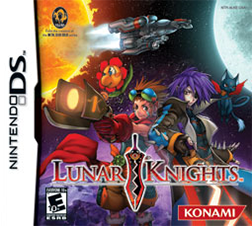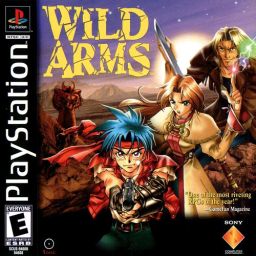Star Ocean is a franchise of science fantasy role-playing video games developed by the Japanese company tri-Ace and published by Square Enix.

Star Ocean is a 1996 action role-playing game developed by tri-Ace and published by Enix for the Super Famicom. The first game in the Star Ocean series, it was released only in Japan in July 1996, and was the first game developed by tri-Ace, consisting of staff that had previously left Wolf Team due to being unhappy with the development process for Tales of Phantasia with Namco in 1995. The game used a special compression chip in its cartridge to compress and store all of the game's data due to possessing graphics that pushed the limits of the Super Famicom. Additionally, the game had voice acting for the game's intro and voice clips that played during the game's battle gameplay, a rarity for games on the system.

Star Ocean: The Second Story, known in Japan as Star Ocean: Second Story, is an action role-playing video game developed by tri-Ace and published by Enix for the PlayStation. It is the second game in the Star Ocean series and the first game in the series to be released outside Japan, arriving in North America in June 1999 and Europe in April 2000, by Sony Computer Entertainment. Taking place in a science fantasy universe, the story centers around a young man named Claude C. Kenny, a cadet from a space-faring Earth organization who is stranded on an undeveloped, medieval-level planet. There, he meets several companions and must stop a plot from an evil organization that spans multiple worlds before finding his way home. The game was the basis of manga and anime adaptations.

Star Ocean: Till the End of Time is an action role-playing game, the third main game in the Star Ocean series. The game was developed by tri-Ace and published by Square Enix for the PlayStation 2 console. It was released in Japan, North America, and the PAL territories. The original Japanese release date was in February 2003 by Enix, its penultimate release before its merger to become Square Enix. It was re-released in 2004 as a two-disc Director's Cut version with bonus features such as new characters and dungeons. The North American and European versions are based on the Director's Cut version with Ubisoft handling publishing rights in Europe. Till the End of Time takes place four hundred years after the events of Star Ocean: The Second Story.

Ratchet & Clank is a third-person shooter platform video game developed by Insomniac Games and published by Sony Computer Entertainment for the PlayStation 2 in 2002. It is the first game in the Ratchet & Clank series.

Robotrek, known in Japan as Slapstick, is a role-playing video game (RPG) for the Super Nintendo Entertainment System (SNES). It was developed by Quintet and published by Enix in both Japan and North America in 1994. Set on the fictional planet Quintenix, the game puts the player in control of a budding robotics expert who is the son of a famous inventor.

Star Ocean: Blue Sphere is an action role-playing video game developed by tri-Ace and published by Enix for the Game Boy Color handheld video game console in June 2001. It is a spin-off entry in the Star Ocean series, acting as a direct sequel to the 1998 PlayStation title Star Ocean: The Second Story. It was later remade for mobile devices, releasing in 2009.

Sentinel Worlds I: Future Magic is a 1988 role-playing video game developed by Karl Buiter and published by Electronic Arts for the MS-DOS and Commodore 64 computer systems.

Bomberman Jetters is an action game for the Game Boy Advance, GameCube and PlayStation 2, and part of Hudson Soft's Bomberman series. The game builds on the gameplay style established in the previous Bomberman series entry, 2002's Bomberman Generation, and features characters and settings from the 2002 anime series Bomberman Jetters. The GameCube version utilizes cel-shaded graphics similar to those of Bomberman Generation, while the PlayStation 2 version does not.

Xenosaga Episode I: Der Wille zur Macht is a role-playing video game developed by Monolith Soft and published by Namco for the PlayStation 2; the game was released in 2002 in Japan and 2003 in North America. It is the first entry in the Xenosaga trilogy and forms part of the wider Xeno metaseries. Gameplay features exploration of environments through a linear narrative, while battles use turn-based combat with the player characters fighting both on foot and piloting large mecha dubbed A.G.W.S.; combat in turn features a system of button combinations for attack types, and multiple leveling systems.

Rogue Galaxy is an action role-playing video game developed by Level-5 and published by Sony Computer Entertainment for the PlayStation 2. The game was released in Japan in December 2005, in North America in January 2007, and in most European countries and Australia in September of the same year. A director's cut of the game was released in Japan in March 2007, which includes all of the added features and improvements made for the North American and European localizations.

Lunar Knights, known in Japan as Bokura no Taiyō: Django & Sabata and abbreviated Boktai DS, is an action role-playing video game, the fourth title in the Boktai series of video games developed by Kojima Productions and announced at E3 2006.

Infinite Space is a 2009 role-playing video game co-developed by Nude Maker and PlatinumGames for the Nintendo DS. It was published by Sega in 2009 in Japan, and 2010 in Western territories. The science fiction storyline, set across the Small and Large Magellanic Clouds, follows the life and growth of Yuri as he first confronts the aggressive expansion of the Lugovalian Empire, then a greater alien threat. Gameplay involves Yuri's fleet travelling across the galaxies, fighting in both scripted battles and random encounters, with the battle system featuring real-time commands and both ships and crew being customizable.

The Earth Fighter Rayieza is a role-playing video game developed and published by Enix. It was originally published in 1985 for the PC-8801, FM-7, X1, and MSX personal computer systems. The game was ported to the Famicom on December 15, 1987 by Nintendo under the title Ginga no Sannin (銀河の三人). The programming was done by Pax Softnica.

Kowloon's Gate is a 1997 adventure video game published by Sony Music Entertainment. Released for the PlayStation in Japan, it is considered a cult hit.

Wild Arms is a role-playing video game developed by Media.Vision and published by Sony Computer Entertainment for the PlayStation. Originally released in Japan in 1996, it was later translated and released in North America in 1997 and Europe in 1998. It features a fantasy setting and motif and 2D computer graphics for normal gameplay, while battle sequences are rendered in 3D.

Growlanser: Wayfarer of Time is a tactical role-playing game developed by Career Soft and published by Atlus. It was originally released for the PlayStation 2 in Japan in December 2003, and later for the PlayStation Portable in Japan in August 2011 and in North America in July 2012. It is the fourth installment in the Growlanser series, with character designs by Satoshi Urushihara. A visual novel fan-disc Growlanser IV: Wayfarer of Time - Return, containing three short stories, was released on PS2 in 2005.

Omega Quintet is a video game developed by Galapagos RPG, a subsidiary of Compile Heart, for the PlayStation 4. A hybrid between an idol simulation game and a role-playing video game, the player plays as Takuto, the manager of the Verse Maidens, an idol group that use the power of song and dance to fight off a phenomenon called the "Blare" and save the world. Omega Quintet is the first game by Compile Heart for the PlayStation 4, and also the first retail game for the PS4 to utilize PlayStation Move. An English version of the game, available in both digital and retail format, has been announced, and was released on April 28, 2015 in the United States and in Europe and Australia on 1 May 2015. A Windows version, produced and published by Ghostlight, was released on December 15, 2017.

Paper Mario: Color Splash is a 2016 role-playing video game developed by Intelligent Systems and published by Nintendo for the Wii U console. It is the fifth installment in the Paper Mario series, within the larger Mario franchise. The story follows Mario and his new ally Huey on a quest to save Prism Island and rescue Princess Peach from Bowser.

The Muppets Movie Adventures is a 2014 platform game developed by Virtual Toys and published by Sony Computer Entertainment, exclusively for the PlayStation Vita handheld system. The title is based on the films The Muppets and Muppets Most Wanted. The game centres around the production of a movie, with characters from The Muppets era serving as the characters in the respective film. The Muppets Movie Adventures was released in Europe on November 5, 2014, with physical copies arriving a short time later. The North American version arrived a year later. Upon launch, the title received mixed to negative reviews.



















